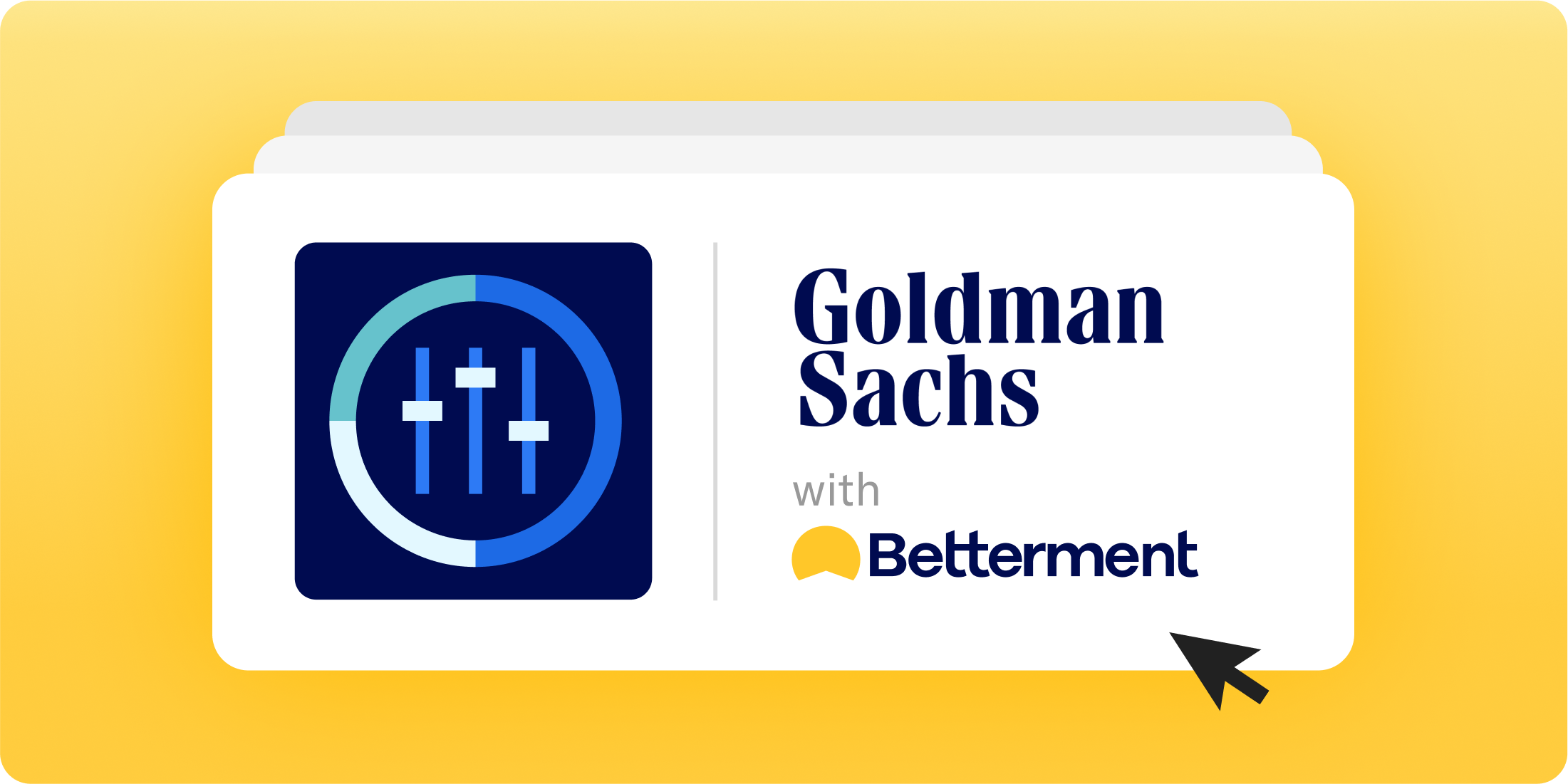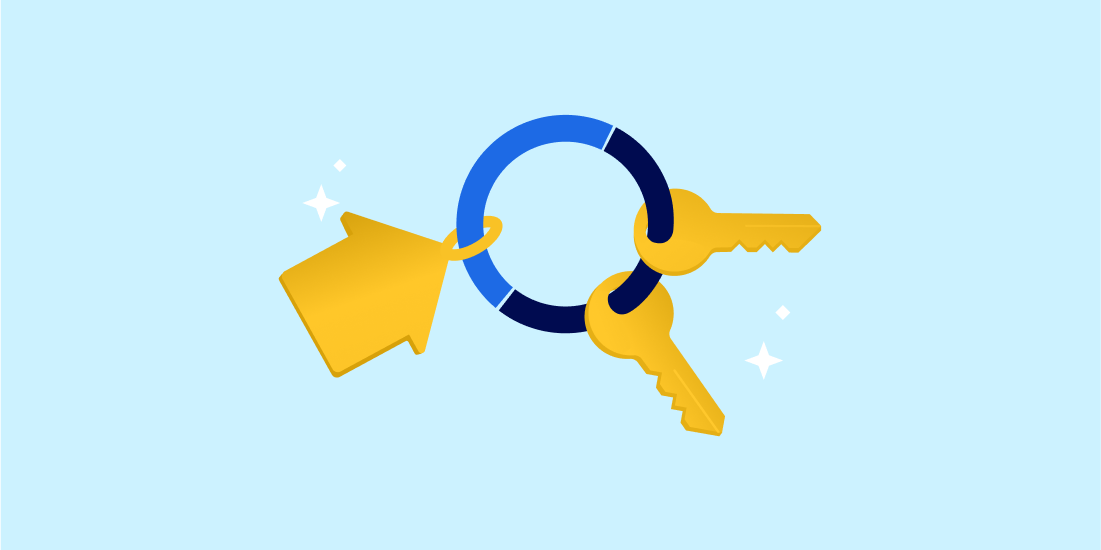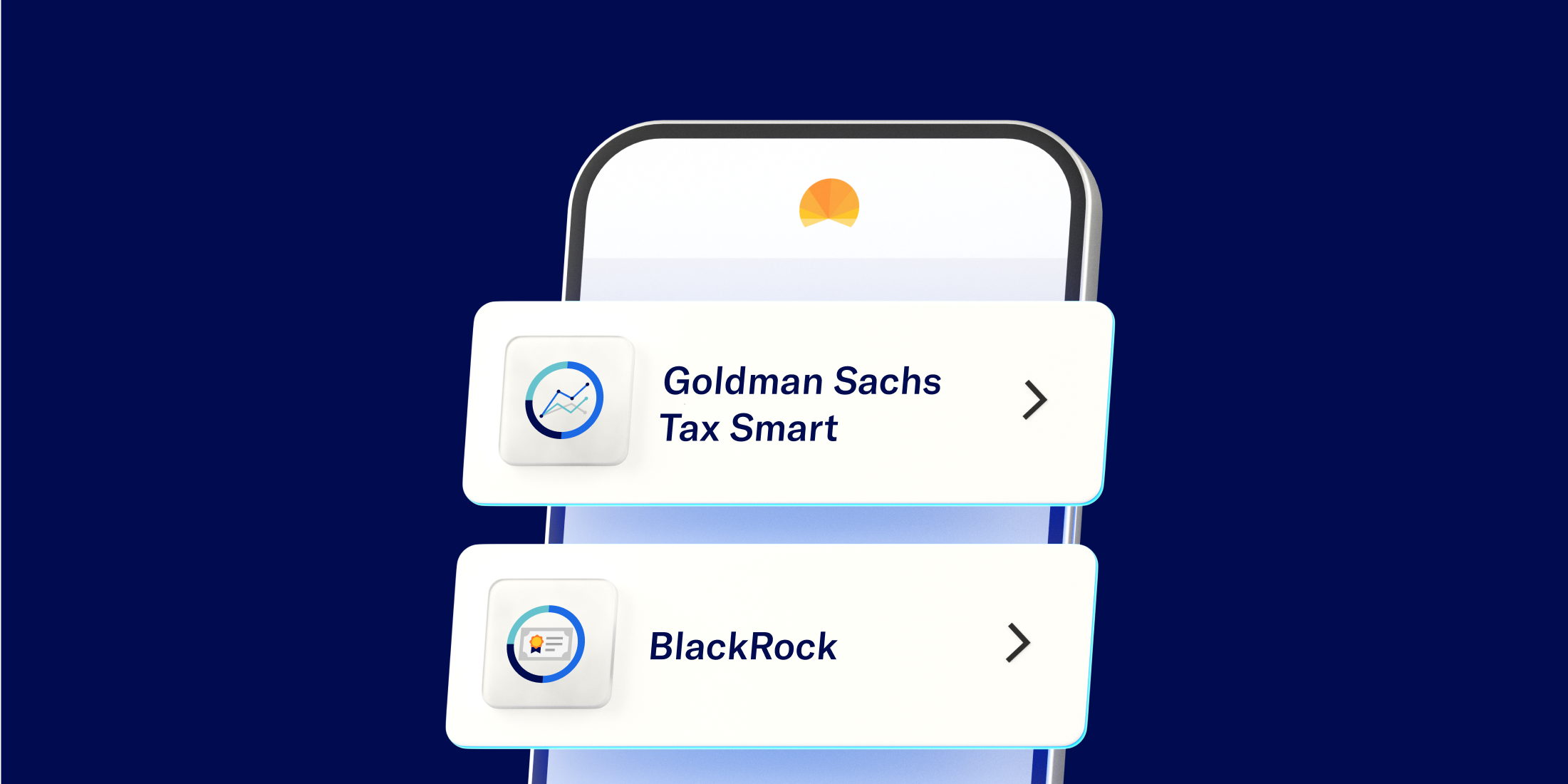Resources

Sort by:
-
![]()
An industry-first, tax-smart bond portfolio
An industry-first, tax-smart bond portfolio Jul 18, 2024 5:30:00 AM See how the Goldman Sachs Tax-Smart Bonds portfolio seeks to offer a strategy with potentially lower risk than investing in stocks, personalized by Betterment to be tax-smart to your financial situation. Key Takeaways: As interest rates eventually begin to drop, bonds may be a good way to earn extra after-tax yield compared to high-yield cash accounts in 2024 and beyond. For high-income investors in higher federal tax brackets (32% and above), certain bond strategies may offer tax advantages compared to high-yield cash accounts. The industry-first Goldman Sachs Tax-Smart Bonds portfolio is personalized by Betterment to your tax situation and seeks to provide a way for higher-income investors to get a tax-smart strategy with potentially lower risk than stock investing and is designed to increase after-tax yield. Over the past few years, investors have been able to put their cash to work in high-yield savings and cash accounts. In fact, the Fed has raised rates 11 times during its current cycle of interest rate hikes beginning in 2022. But those rate hikes have come to a pause. The last rate hike was in July 2023, and the world is waiting for the Fed to lower rates. So what does that mean for investors? Once the Fed lowers rates, those high-yield savings and cash accounts will follow suit, likely no longer offering the attractive 4% or even 5%-plus yields. The case for bonds in 2024 and beyond As interest rates begin to drop, bonds may be a good way to earn extra yield in 2024 and beyond. Investors looking to continue to earn yield should consider three points: Variable interest rates on high-yield cash accounts will likely fall when the Fed lowers rates, but bonds, on the other hand, tend to benefit from rate cuts because as yields fall, bond prices rise and generate return. Bonds, especially short-maturity bonds, can be a good choice to help preserve your money compared to stocks. For high earners, especially in the 32% or greater tax bracket, certain bonds may offer tax advantages compared to high-yield cash accounts. As the Fed reduces rates, bonds may be a wise alternative. Just a reminder, even short-term bond portfolios carry a bit more risk than cash management accounts, which are generally FDIC-insured and provide the stated yield. Bonds are securities that are exposed to market volatility but, in return, provide the opportunity to increase after-tax yield, which is the money you actually get to keep after paying taxes. Meet the Goldman Sachs Tax-Smart Bonds portfolio Our new Goldman Sachs Tax-Smart Bonds portfolio is industry-first, representing a unique opportunity for higher-income investors. The portfolio is designed to reduce risk compared to investing in stocks and increase after-tax yield compared to a cash account. Betterment does all the work for you behind the scenes to personalize the portfolio to your tax situation while leveraging Goldman Sachs' expertise in bond markets to aim to generate additional after-tax yield. But how does the portfolio work? Let’s look at an example of a hypothetical $100,000 investment… The power of after-tax yield The Goldman Sachs Tax-Smart Bonds portfolio is designed to generate additional after-tax yield compared to a cash account. By increasing after-tax yield, you may earn a higher return after taxes and fees than a regular high-yield cash account, which can be an advantage for high-income investors. Take a look at the standard yield and the after-tax yield of a hypothetical $100,000 placed in our Cash Reserve portfolio and our Goldman Sachs Tax-Smart Bonds portfolio by an investor in the 35% tax bracket.* Pre-Tax Yield After-Tax Yield** Take Home on $100,000 Cash Reserve 5.00% (variable)* 2.60% $2,595 Goldman Sachs Tax-Smart Bonds Portfolio 4.61% 2.85% $2,864 **Annualized Blended 30-day SEC Yield. After-tax assumes individual filing single in CA, 35% federal tax rate, and $260K income. Results may vary substantially. There are important risks to consider in comparing these products to each other, which we discuss in further detail below. The information provided is not tax advice and customers should obtain independent tax advice based on their particular situation. You can see that after taxes are paid, the Goldman Sachs portfolio comes out on top in our hypothetical scenario, which is illustrative only. What is after-tax yield, exactly? After-tax yield is the amount, expressed as a percentage of the investment, that you can expect to receive from an investment after paying taxes. We use after-tax yield to help you compare the potential profitability of portfolios that are taxed differently, such as our cash and bond portfolios. Municipal bonds are exempt from tax at the federal level, offering an after-tax benefit to higher income investors. Treasuries are exempt at the state level—particularly advantageous for those residing in high income tax states. After-tax yield for the Tax-Smart Bonds portfolio is calculated as the weighted average of 30-Day SEC yields for each ETF in the portfolio, net of fees (0.25%), and net of taxes, as determined by your Betterment profile data. After-tax yield reflects interest earned after fund expenses. How does the Goldman Sachs Tax-Smart Bonds portfolio take after-tax yield into account? Here’s how we work to take after-tax yield into account: First, Goldman Sachs built the portfolio with a mix of short-term bond ETFs containing treasury, municipal, and corporate bonds, which seek to offer lower risk than stock investing, leveraging their expertise in bond markets. Next, Betterment uses the information that you provide about your tax situation, including your state residency, federal tax bracket, and income, to personalize the portfolio for you. Finally, the portfolio strategy considers market conditions and taxable equivalent yields monthly. When you let Betterment know that your tax situation has changed and as interest rates shift, Betterment will rebalance your personalized portfolio. A spectrum of choices to optimize your cash At Betterment, we believe in investor choice. That’s why we continually create innovative portfolios to provide you with options based on your risk tolerance and desire for yield. And as interest rates evolve, your cash should still work for you. Diving deeper into your cash options When it comes to considering risk and yield—and choosing the portfolio right for you—we like to compare portfolio options across a few variables. First is the risk of losing money. With most investments, you potentially risk losing some of the amount of your initial investment, also called your “principal.” Our Cash Reserve account is the only portfolio offering FDIC insurance through program banks† to secure your money during volatile times. After Cash Reserve, our Goldman Sachs Tax-Smart Bonds portfolio is our option with the potential lower risk than investing in stocks where losses on principal, while still possible due to market volatility, are less likely. Second, we have liquidity. Liquidity is how easily (or not) available your funds are. It can be risky if your funds are locked up for a period of time, but you need them to cover expenses. All three portfolios provide access to your money when you need it (inclusive of standard ETF settlement times). Third, we account for tax. We offer tax-smart strategies to increase a portfolio’s after-tax yield. Our Goldman Sachs Tax-Smart Bonds portfolio offers this kind of tax-smart strategy designed for high-income investors. Breaking down the spectrum of portfolio choices available at Betterment Cash Reserve: If you want low risk, a Cash Reserve account can provide you the stated variable APY while preserving your funds in FDIC-insured accounts at our program banks. Goldman Sachs Tax-Smart Bonds: If you’re a higher-income investor (in a 32% federal tax bracket or above) and want to take more risk than Cash Reserve for the chance to potentially increase after-tax yield, then the Goldman Sachs Tax-Smart Bonds portfolio may be an option for you. BlackRock Target Income: If you’re comfortable with more risk than Cash Reserve and the Goldman Sachs Tax-Smart Bonds portfolio, our BlackRock Target Income portfolio is built to target income across four levels of risk while reducing volatility compared to stock portfolios. See which option might be best for you When you sign up for a bond investing account, Betterment will provide you with a personalized after-tax yield to help you compare our Cash Reserve account to our bond portfolios. Based on your degree of risk tolerance and the various after-tax yields of these three products, which are calculated based on the information provided to Betterment in your financial profile, you can select which portfolio is right for your goals and financial situation. Get started today. -
![]()
How to talk money with your aging parents
How to talk money with your aging parents Jul 9, 2024 11:43:32 AM Talking about their financial future isn’t easy, but it’s important. Talking money with your parents is no one’s idea of a good time. But as you enter middle age, and they enter their Golden years, it’s important to create an open dialogue. Because one day, you could be pressed into duty helping them manage their finances, or even stepping in with financial support yourself. Pew Research Center polled adults with an aging (65+) parent and found it’s more common than you might think. So before you buy another bouquet of flowers, or another tacky tie, consider gifting your parents an awkward but meaningful conversation on money’s role in aging with grace. Here's how. Step into their shoes, then switch mindsets If you think it's hard having this “talk” with your parents, imagine how they must feel. Maybe they're afraid their money won't last. Maybe they're too embarrassed to ask for help. From anyone, let alone someone whose diaper they once changed (and changed, and changed). This sort of empathy sets the stage for a true heart-to-heart. Sure, you could share any number of practical tips—everything from catch-up contributions and safe withdrawal strategies to (quick plug) how awesome Betterment is and how easy it is to switch—but those conversations are best left for another day. What matters most in these first few exchanges is to build trust, and to come at things through the lens of curiosity, not problem-solving. To that end, we leave you with a few suggestions. Three ways to set the table, and three icebreaker ideas Depending on your relationship with your parents, there may be no way around this: It will be awkward. Your inquiries may be met with resistance. So start getting comfortable with both possibilities. A few tips can help your odds: Pick a boring time. Steer clear of hectic holidays. Start small. Spread things out over multiple conversations. Stay curious. The questions matter more than the answers. Now, once it’s time to actually start the conversation, consider a few icebreakers: The “23andMe” angle. “I’m curious, how did your parents handle their finances as they aged? Did you ever talk about it with them?” The “I’ll go first” angle. “With the kids getting older, I’ve been thinking more and more about estate planning lately. But it’s all so overwhelming.” The CNBC angle. “Did you see the Dow just dropped [insert number] points? I know it’s easy to overreact, but it stings seeing my portfolio shrink even just a little.” Regardless of where things go from here, remember to give yourself credit. You just took the hardest step (the first one) in joining your parents on their financial journey. And if there ever does come a day when they consider joining you at Betterment, our team is here to help. -
![]()
The keys to building wealth, whether you rent or buy
The keys to building wealth, whether you rent or buy Jun 14, 2024 4:07:01 PM There's more than one path to prosperity. To rent or to buy. At some point in your life, adulting may very well boil down to this one anxiety-inducing question. But it’s really two questions wrapped in one. The first is highly-personal: “Which lifestyle is right for me, right now?” And that answer is totally up to you. It’s largely based on individual circumstance, personal preference, and how much time you can handle at The Home Depot. But the second question? It deals with dollars and cents, and it’s right up our alley. So we’re here to offer you a sigh of relief, then help you turn hypotheticals into concrete action. Is renting or buying your primary residence the smarter money move? We’re in the business of building long-term wealth, and on that topic the historical data is pretty clear: both renting and owning a home can generate large sums of wealth in the long run. In the case of homeownership, that’s assuming you live there long enough to build equity and recoup the big, additional expenses that come with purchasing and maintaining it. And with renting, that’s assuming you invest wisely the extra money you would’ve otherwise spent buying and maintaining the home. A real estate investment firm recently crunched 50 years of data (see pages 3-5 for all of their assumptions) to see exactly how each hypothetical scenario fared. Wealth after 30 years *Data shown is for illustrative purposes only, and is not reflective of any Betterment portfolio or performance. As such, this graph does not reflect any of Betterment’s management fees, transaction costs or fund expenses. Renting slightly edges out buying in this study, although a buyer with a paid-off home could arguably close the gap in subsequent years if they invest their old mortgage payments. But these nitpicks miss the point, because in terms of wealth, both people are doing just fine in this hypothetical. So let’s all take a moment to exhale, because you can do well no matter which path you take. In the case of renting, it just requires you to actually invest those savings and not spend them. And we can help with that. How to realize the potential of “renting + investing” Let’s use the median house in America as an example. It costs roughly $415,000. Here’s a rough approximation of how much money you would need, both up front and ongoing, to buy and maintain it. Keep in mind the ongoing costs listed below exclude the mortgage payment itself. Up-front expenses Amount Downpayment (20%) $83,000 Closing costs (2%) $8,300 Agent commission* (3%) $12,450 Total $103,750 Ongoing expenses Property tax** $484 Homeowners insurance $179 Maintenance $534 Total $1,197/month Pay attention to your emotions here, because they can help guide your decision making. If you can’t imagine saving and investing this much money right now, then you may struggle to afford owning the median U.S. home. And that’s okay! One's answer to the Rent vs Buy question may very well change multiple times throughout life. Just remember you can still build wealth while renting. Crunch the numbers above based on your own budget, then follow two steps to see the strategy through to the end: Start saving for those upfront costs now. Once you have that amount in hand, start investing the equivalent of those monthly non-mortgage costs via recurring deposit. Now it’s no longer a hypothetical. You’re putting those savings to work. Should you decide to buy down the road, you’ll be more financially ready—and the tradeoff will be clear as day: Buy a house. Or keep saving at your current levels. There’s no wrong answer here. Whatever you decide will be the right decision for you. And it’ll be an informed one. -
![]()
Make Your Money Hustle: Bond Investing
Make Your Money Hustle: Bond Investing May 9, 2024 3:42:01 PM Bonds can be confusing, but we’re here to simplify them. Here’s the TL;DR: Bonds are loans you give to companies or governments who pay you back with interest. Bonds generally earn more return than high-yield savings accounts while taking on less risk than stocks. Bonds can be bought through several sources, including a broker, the U.S. government, or a diversified ETF like the BlackRock Target Income portfolio offered by Betterment. Congrats—you made it past the TL;DR. Next, we’ll dive deeper into how bonds may be able to bring balance to your investments, filling the gap between cash and stocks. In just a few minutes you’ll walk away knowing: The basics of bonds The benefits of investing in bonds An easy way to buy bonds As interest rates plateau—and eventually begin to drop—bonds may be a good way to earn extra yield in 2024. The basics of bonds No need to read a book about bonds—here are three Q&As that give you the basics. Question 1: What is a bond? Answer: A bond is basically a loan that you provide to an entity such as a business or government that wants to raise money. You can buy and hold a bond directly from the issuer (e.g. buying US Treasury bonds from TreasuryDirect) or choose to buy and sell bonds on the secondary market (e.g. an online broker). Question 2: How does a bond work? Answer: After you “loan” your money to the entity issuing the bond, they agree to: Pay back your principal: The issuer promises to pay your initial money back, aka your principal, by a specified date called the bond’s maturity. Pay you interest: You’ll receive periodic interest payments based on the annual interest rate paid on a bond, called the coupon rate. These interest payments are either distributed to you or reinvested into your investment on a consistent schedule. Question 3: Are there risks to bond investing? Answer: Generally, bonds are less risky than stocks, but that doesn't mean they are without risk. Examples of these risks include: Credit risk: There’s a chance that a bond issuer won’t pay you back. Interest rate risk: There is a chance that the value of the bond will go down as interest rates go up. Long-term bonds have greater interest rate risk than short-term bonds. Most bonds are rated based on the bond issuer's financial strength and ability to pay a bond's principal and interest. Like stock investments, bonds with less risk offer less potential for return (aka lower yields). Less risky bonds include higher-quality bonds (more likely to be paid on time) or bonds with shorter maturities (length until full repayment). The benefits of investing in bonds For investors looking to put some of their cash to work but not wanting to go all-in on the stock market, here are three benefits that bonds can offer, making them complementary to cash and stock. 1) Bonds can help you avoid market volatility Unlike stocks, bonds don’t represent a share of ownership in a company. Because of this, you won’t see the value of a bond increase as much as a stock when a company grows, but you generally also won’t see it decrease as much as a stock when a company struggles. 2) Bonds can help you preserve wealth Bonds, especially short-maturity bonds, can be a good choice to help preserve your money while potentially earning more return than cash in a traditional savings account, money market account, or CD. 3) Bonds can help you generate income Because the entity issuing a bond typically pays the bondholder interest on some regular schedule, they can help generate consistent income with less risk than stock investing. An easy way to buy bonds Most bonds don't trade directly on centralized markets like stocks, making it more challenging to invest in individual bonds. You can buy individual bonds from a broker or directly from the US government, but both of those options require DIY knowledge and time to build a diversified portfolio. An easy way to invest in a diversified portfolio of bonds is to invest in a bond ETF. A bond ETF, or exchange-traded fund, trades on stock exchanges, like a stock ETF. In one purchase, a bond ETF offers investors a way to gain exposure to a diversified portfolio of bonds, which can include government, municipal, corporate, and international bonds. Bond ETFs aim to provide regular income through interest payments from the underlying bonds and offer the flexibility of buying and selling shares on an exchange throughout the trading day. The BlackRock Target Income portfolio offered by Betterment The BlackRock Target Income portfolio offered by Betterment is an all-bond investing strategy that can generate up to 6.33% in yield with less risk than equity investing. The portfolio is designed to help you avoid market volatility, preserve wealth, and generate income, with all dividends automatically reinvested to grow over time. There are four options, each consisting of 100% bonds, targeting increasingly higher yields, and should be selected based on your risk tolerance. The portfolio is built by BlackRock, one of the world’s leading fund managers, offering some of the best options for balancing risk and return. The BlackRock Target Income portfolio includes access to bond asset classes such as US High-Quality Bonds, US Short-Term Treasury Bonds, US Mortgage-Backed Bonds, High-Yield Bonds, Floating-Rate Bonds, and others. We make it simple to invest funds into your BlackRock Target Income portfolio, with three options: Make a one-time deposit. Set up recurring deposits from Betterment Checking or an external account. Schedule recurring transfers from your Betterment Cash Reserve account. Ready? Start investing in the BlackRock Target Income portfolio today. -
![]()
When will interest rates finally start to fall?
When will interest rates finally start to fall? May 8, 2024 11:40:52 AM We look back at the last 40 years of interest rate peaks and plateaus for a guide. This decade of investing has come to be defined by one thing: interest rates. The federal funds rate has sat north of 5% for more than a year now, a level neither seen nor sustained since the runup to the Great Recession. Which has everyone from bond traders to homebuyers asking the same question: When will rates finally start to fall? Optimism that the Federal Reserve would cut rates throughout 2024 was widespread to begin the year, but inflation’s small uptick to start the year has thrown cold water on those expectations. So how far in the future could the first cut be? No one knows the exact answer, but history offers several reference points. Rate peaks are common, plateaus less so When you take a look at the past 40 years, the cyclical nature of short-term rates stands out: The economy heats up, the Fed raises rates. The economy cools down, the Fed lowers rates. Rinse and repeat. Historically-speaking, however, it’s usually only a matter of months until rates drop after peaking, which means our current cycle is starting to look more like a plateau by comparison. It’s already lasted longer than all but one other cycle since the 1980s. Rate peaks have lasted 8 months on average since the late 80s This holding pattern isn’t without reason, of course. Inflation has slowed considerably since 2022, but it’s been stuck in its own holding pattern as of late, hovering more than a full percentage point over the Fed’s stated target of 2%. On the flip side, supply and demand appear better balanced, so if inflation resumes its slowdown in the coming months, then signs point to possible rate cuts late in the year. So what’s a saver to do? Consider deploying excess dollars Whenever the federal funds rate falls, other interest rates follow, including variable interest rates on high-yield cash accounts. Stocks and bonds, on the other hand, tend to benefit from rate cuts. Because of this, we suggest taking another look at your cash situation. If you’ve been stockpiling cash above and beyond an emergency fund and other major purchases, it may be the time to start investing some of that excess in the coming months. Feeling anxious about diving into the market right now? Our all-bonds BlackRock Target Income portfolio offers the potential for higher yields than cash in exchange for taking on some risk. If or when a long-term goal comes to mind for those funds, consider switching to a diversified portfolio of stocks and bonds. And keep in mind you don’t have to move all your money at once. With a few clicks, you can set up a recurring internal transfer to slowly but steadily dollar-cost average your way from cash to investing. -
![]()
How to plant the seeds for a smoother tax season
How to plant the seeds for a smoother tax season Apr 29, 2024 10:46:32 AM Whether you overpaid or underpaid, taking a few actions now can make next year’s taxes less of a headache. Rejoice! Another Tax Day has come and gone. But don’t go shredding your receipts in celebration just yet. Now’s a good time to reflect and plant the seeds for a smoother tax season next year. Because whether you overpaid and received a refund (roughly two-thirds of Americans do) or underpaid and had to cut a painful check, you can take a few actions now that have the potential to pay off down the road. For the purpose of this article, we’ll divvy up these tips into three buckets: A tip for over-payers: Ignore the internet A tip for under-payers: Dial in your withholding A tip for all taxpayers: Save more to save more in taxes A tip for over-payers: Ignore the internet The internet commentariat will snidely tell you that getting a tax refund is like giving the government an interest-free loan. The implication being, you should stop doing it. And of course, if your tax refund is pushing five figures, maybe you’d be better off putting some of that cash in your pocket (or the market) earlier in the year. But the average tax refund typically falls in the ballpark of $3,000-$4,000. And we’ll be the first to tell you that in many cases, there’s little wrong with overpaying by that amount. Cash windfalls such as these can supercharge your savings goals. There’s also an emotional benefit to “found” money. Even if that money was yours all along. And the alternative of underpaying can sometimes have pricey consequences. A tip for under-payers: Dial in your withholding Most salaried workers have income taxes withheld from their paychecks throughout the year. Case closed, right? Not always. Come tax time, some realize they still owe a substantial amount of taxes, so much so that the IRS slaps them with an underpayment penalty on top of their already nausea-inducing tax bill. It happens more than you think. The IRS dished out more than $1.8 billion of these underpayment penalties to about 12 million people in 2022 alone. If you’re one of these unfortunate souls, you have our sympathies. Now here’s our two-step tip: Step 1: Increase the amount of income tax withheld from your paycheck by completing a fresh W-4 form and submitting it to your employer. Step 2: As a backup plan, consider opening a new Cash Reserve account and setting up recurring deposits—just in case your withholding estimate was off and you still owe taxes next year. How much cash should you set aside? One approach is to shoot for 10% of your total tax amount from this most recent return. You can find this amount on line 24 of your Form 1040. A tip for all taxpayers: Save more to save more on taxes One surefire way to make tax time less painful is to pay less taxes in the first place. Sure, you could accomplish this by moving to one of the nine states with no income tax, but have you seen those Zestimates® lately? We’ll go ahead and unheart that idea for you. By comparison, an easier way to lighten your tax load is by contributing more to a traditional IRA and/or traditional 401(k). Between those two accounts, eligible individuals can reduce their taxable income by up to $30,000 in 2024. For someone making $77,000, the point at which the IRS starts to phase out a traditional IRA’s tax benefits, that could mean more than $5,000 in federal tax savings. And it all comes with the sweet, sweet side effect of saving more for retirement.






